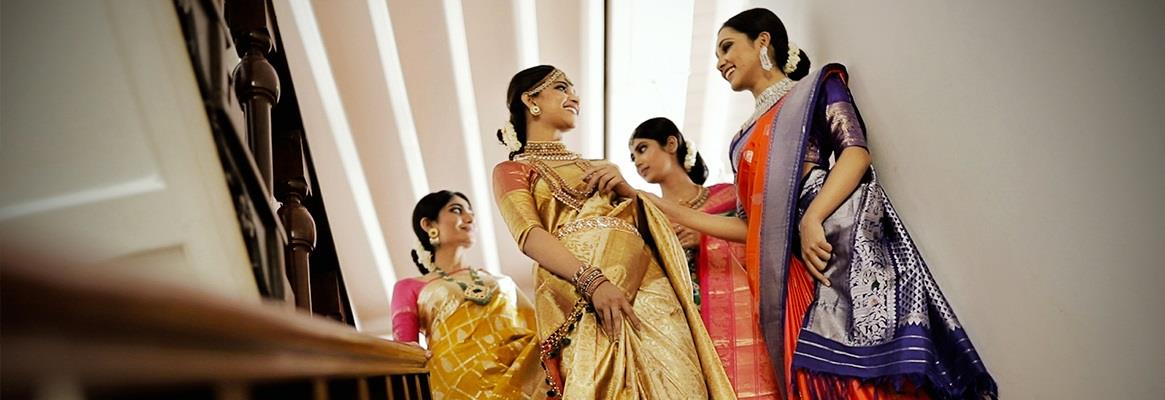The rich kanchipuram or kanjeevaram sari, a GI* product from Kanchipuram town, located 60 km from Chennai, has long remained a cherished trousseau piece. Fibre2Fashion explores the history of the kanjeevaram sari to the current day scenario.
It is a dream of every south Indian bride, for that matter any bride in any corner of the country, to dress up in a perfect kanchipuram sari on the most important day of her life. For a long time, reds, yellows, magentas, creams with red borders, have been the traditional colours donned by Indian brides, but now new age brides are opting for pastels as well. It has been a long-standing tradition for the extended family of brides-to-be to flock to this town called Kanchipuram located 60 km from Chennai, to shop for the bridal trousseau and saris. Have you ever wondered what makes kanchipuram saris so special?
Kanchipuram aka kanjeevaram saris are world renowned handwoven silk saris famed for their lustre, finish and incomparable beauty. Like most handloom weavers of India, the motifs are inspired by nature like flowers, creepers, animals and birds which have been in existence for more than two thousand years. However, the added characteristic of a kanchipuram sari is the use of mythological motifs inspired by the temple architecture of south India. Yazhi or yali (pronounced ya lee) - a mythical animal that is a chimera of a lion, elephant and a snake is an integral part of a kanjeevaram sari. The yazhi may have the face of a lion with paws and tail, fangs like a snake, body, hind legs and trunk of an elephant. Although there are many forms of yazhis (the base animal that they were created from), three are very common -- simma (lion) yazhi, makara (capricorn) yazhi and yannai (elephant) yazhi. Horse-headed, human-headed or dog-headed yazhis in temples are all used as motifs in kanjeevaram saris. Iruthalaipakshi or Ganda Bherunda is another mythological bird whose motifs are widely seen in the saris. It is a two-headed eagle which is believed to possess immense strength according to Hindu mythology. It was the emblem of the erstwhile kingdom of Mysore under the Wodeyar dynasty and is now used as the official insignia of the Karnataka state government. It is believed that these motifs in the outfit protect the wearer from negativity.
The town Kanchipuram flourished during the reign of Krishnadevaraya and was considered as one of India's seven sacred cities. It was the historical capital of the Pallavas and Cholas. The kanchiveeram weavers call themselves the descendants of Maharishi Markandaya, who is considered the master weaver of the gods. The two weaving communities -- Devangas and Padmasalis who hail from Andhra Pradesh, migrated to Kanchipuram and established the city as a prime place rich in cultural, spiritual and architectural traditions. The skill of weaving a kanchipuram sari has been passed on over the generations with great care. It is an art that is honed by practice by the weavers since young age and improvised with creativity and vision.
Although China is the largest producer of silk in the world, the silk used in kanjeevaram saris is pure form of mulberry silk that is cultivated in Karnataka and Tamil Nadu. The pure gold and silver comes from Surat in Gujarat. The silk thread is dipped in rice water and sun-dried before weaving so that the thickness and stiffness is increased. Using a double warp for weaving is another specialty which makes the saris stay stronger and also makes it dearer as compared with its counterparts from Gadwal, Dharmavaram or Banaras. In this method, each thread is made up of three single threads twisted together. The thread is then interlocked with a thin silver wire and woven through and at last a golden thread is used to complete the procedure.
Though one can find saris in several shops of Kanchipuram, finding a real kanjeevaram is a tough task. Many weavers have now turned to alternate careers due to the advent of power looms. And those saris which are handwoven do not follow the traditional process.
Designing is the most crucial part in the production of kanchipuram saris. The motifs are hand drawn, converted to graphs, and transferred to punch cards. The Korvai technique of Kanchipuram is one of the treasured techniques of South India which is slowly fading due to several external factors including the fact that two people are required to operate the shuttle where body, border and pallu are woven separately and then interlinked together.
It is our duty to preserve and patronise these types of heritage craftsmanship by encouraging these handcrafted saris. The whole culture of South India can be seen in a single kanjeevaram sari just like a textbook of South Indian art history -- such is the glory of a kanjeevaram sari. The exquisite deep-rooted beauty of the motifs has timeless appeal in textile and architectural traditions. The kanjeevaram has maintained its position in the minds and hearts of women for decades and it remains an abiding symbol of auspiciousness in festivals and ceremonies.
* A Geographical Indications of Goods tag conveys an assurance of quality and distinctiveness which is essentially attributable to the fact of its origin in that defined geographical locality, region or country. GI Laws protect an item from being duplicated in any way elsewhere.








Comments